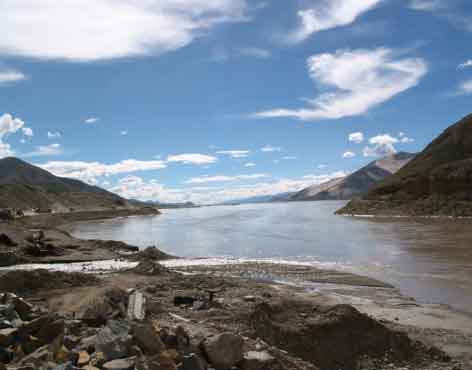| Legole.Com Discover china. Explore the beauty and wonder of the land, people, and culture of China. |
 |
|
|
 |
 Tashilhunpo lies 2 kilometers (1.2 miles) west of Shigatse city. It lies at the foot of Drolmari, or Tara's Mountain, on the west side of Shigatse and today is one of Tibet's most influential monasteries. It was founded in 1477 by Gendun Drubpa, the first Dalai Lama and a most outstanding disciple of Tsong Khapa. In 1600, the Fourth Panchen Lama started a large-scale expansion, which was carried on by his successors. In 1713, the Fifth Panchen Lama's title and status were finally ascertained by the Chinese emperor. The monastery became the seat of Panchen Lama. Tashilhunpo had over 4,000 monks and was organized like Lhasa's great monasteries. It had four trantric colleges, each with its own abbot. The monastery buildings are currently 300 thousand square meters in size. Today, there are nearly 800 monks in Tashilhunpo. Tashilhunpo lies 2 kilometers (1.2 miles) west of Shigatse city. It lies at the foot of Drolmari, or Tara's Mountain, on the west side of Shigatse and today is one of Tibet's most influential monasteries. It was founded in 1477 by Gendun Drubpa, the first Dalai Lama and a most outstanding disciple of Tsong Khapa. In 1600, the Fourth Panchen Lama started a large-scale expansion, which was carried on by his successors. In 1713, the Fifth Panchen Lama's title and status were finally ascertained by the Chinese emperor. The monastery became the seat of Panchen Lama. Tashilhunpo had over 4,000 monks and was organized like Lhasa's great monasteries. It had four trantric colleges, each with its own abbot. The monastery buildings are currently 300 thousand square meters in size. Today, there are nearly 800 monks in Tashilhunpo.
The construction of the Main Chanting Hall (Tshomchen) took 12 years. It is the oldest building in the monastery. In front of the hall, there is a flagstone debating courtyard, where Panchen Lamas made religious speeches to the lamas. The courtyard has walls covered by a thousand Buddha Sakyamunis, which were enshrined in the walls. The Main Chanting Hall, capable of holding 2000 chanting monks, contains the Panchen Lamas' throne and three chapels. The Sakyamuni Chapel houses a 24-foot statue of Sakyamuni flanked by his disciples, which was dedicated to his religious teacher by Gendun Drubpa. To the west is the Maitreya Chapel, which contains an 11-meter (36 foot) high Maitreya flanked by Avalokiteshvara and Bodhisattva Manjushri, which, according to history, were made by Gendun Drubpa himself. To the east is the Tara Chapel, in which a White Tara, flanked by two Green Taras, is enshrined. A Tara is a deity in the Tibetan Buddhist religion. A Green Tara is a young girl and has a mischievous or playful nature, while the White Tara is represented as a mature woman, full-breasted and wise.
The Maitreya Chapel was the tallest building in the monastery, 30 meters (98 feet) in height. The chapel lies at the west end of the monastery, and was founded in 1914 by the Ninth Panchen Lama. The chapel houses the world largest brass statue of Maitreya. The Maitreya, with its hands in a symbolic pose of teaching, is 26.2 meters (86 feet) high. The statue is seated on a 3.8 meter (12 foot) high lotus throne. A single finger is 1.2 meters (about 4 feet) long, while a foot is 4.2 meters (about 14 feet) long. The statue is composed of approximately 280 kilograms (614 pounds) of gold, 150 tons (330,000 pounds) of brass and about 1400 precious gems like huge diamonds, pearls and amber. Inside the chapel, stairways and platforms were built around the Buddha. pearls and amber. Inside the chapel, stairways and platforms were built around the Buddha. Visitors may climb the stairs and view the Buddha on many different levels, from the Lotus throne and then continuing upward to the head of the Buddha.
In the Fourth Panchen Lama's Stupa Chapel, visitors may see the stupa tomb of the Fourth Panchen Lama's. Comparable with any in Tibet, the stupa was built in 1662 and was finished four years later. The 11 meter (36 foot) silver and gold stupa contains 85 kilograms (187 pounds) of gold, much more silver and brass and countless precious gems. In 1982 and 1985, national fund monies were allocated to the monastery to renovate the chapel and the stupa. To its left is the Tenth Panchen Lama's Stupa Chapel. After the death of the tenth Panchen Lama in 1989, 64 million RMB and lots of gold, silver, and gems were immediately allocated by the central government to build his stupa. In 1993, the 11 meter (36 foot) stupa was completed and the lama's body was placed inside.
The Thangka Wall sits northeast of the monastery. The huge wall, 35 meters (115 feet) in height and 40 meters (131 feet) in width, can be seen from faraway. Founded in 1468, it was a memorial monument to commemorate the birth, nirvana and initiation into Buddhahood of Sakyamuni. Every year on April 14th of the Tibetan calendar, gigantic thangkas of Buddha are displayed on the wall.
In addition, the trove of thangkas, murals and other religious and artistic treasures certainly will impose an indelible impression upon visitors.
Admission Fee: RMB 55
Opening Hours: 08:10 to 16:00
Recommended Time for a Visit: Three hours
Bus Route: Tashilhunpo Monastery is in the west of Shigatse, you can walk there. |
 |
|
|
 |
|
